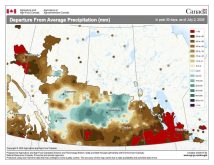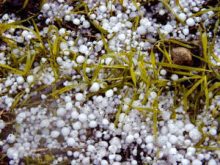Severe storms June 14 put producers up against the clock recently as hail-damaged fields clashed with looming seeding deadlines.
The storm may have forced producers into a shotgun decision on reseeding, Manitoba Agriculture pulse specialist Dennis Lange said during a June 20 Crop Talk webinar.
Soybeans were among the largest concerns after the June 14 storm.
The pulse specialist normally urges producers to wait four or five days before declaring a field a lost cause. The storm’s timing however, right up against Manitoba Agricultural Service Corporation’s seeding deadlines, added a time crunch to those assessments.
Read Also

Thunderstorms and straight-line winds
Straight-line winds in thunderstorms can cause as much damage as a tornado and are next on our weather school list exploring how and why severe summer weather forms.
Farmers were already unable to make another try for soybeans, with even the most generous MASC seeding deadlines closing for that crop by June 11. But other options were also up against the clock, with the window for canola, as well as most cereals, closing June 20.
“Some of the most severe crops have already been reseeded and they were reseeded to wheat or canola,” Laryssa Stevenson, Manitoba Pulse and Soybean Growers production specialist for western Manitoba, said. “Some of the less severe (damaged) crops, they’re being left, because, for the most part, in-crop herbicide had already been applied, so that investment had been made in the crop and, in terms of weed pressure, it was very low.”
Stevenson said soybean fields she has scouted in the Minto area range from a complete loss to less damaged crops that might still be salvaged.
“At this point, we are starting to see regrowth,” she said. “Any of the buds that are left on the plant, there’s a new trifoliate that’s starting to pop out. If you aren’t seeing any regrowth at this point, it probably means that the plant is shut down and died.”
The yield hit may depend on stem damage, according to an ongoing joint study by the University of Manitoba’s Kristin MacMillan and the Manitoba Pulse and Soybean Growers. The study suggests a 45 per cent yield loss if a plant must regrow from the cotyledons and 18-25 per cent yield loss if unifoliate and cotyledons both survive. The study found only minimal loss with higher stem damage.
Stevenson says many of the fields she surveyed by Minto are down to the cotyledons.
Lange urged producers to count surviving plants compared to the prior stand.
“If you do decide to keep the field, you have to keep it clean, which means good weed control through the season,” he said. “More than likely, if you’ve got the hailstorm through there, the stand reductions are going to be significant.”
MASC’s claim services manager, David Koroscil, says overall crop damages may not be as severe as first thought, although adjusters are still out in the field and some regions face significant damage.
The company has noted “reasonable” recovery from canola crops and regrowth in cereals.
“Producers put claims in for potential reseeds, as Wednesday was the seeding deadline,” he said. “Once the weekend passed and the beginning of the week, they were finding that a lot of those fields were starting to come back.”
MASC received 250 spot hail claims and 120 reseed claims due to hail as of June 18.
Greenfeed is still an option for farmers who missed the deadline, Koroscil said, although largely limited to producers with livestock or a market for the feed. MASC’s extended seeding window for greenfeed stretches to July 15.
Some farmers may also decide to put the crop to winter cereals later in the season, Koroscil added, although Stevenson says she has not heard any pulse producers planning for that at this time.
“We’re obviously still out in full force,” Koroscil said. “We were able to keep up for the most part and accommodate producers, anyone who wanted to reseed by the Wednesday deadline. There were situations where we had to leave strips so that we could appraise them once the crop started to regrow again, because it was too early to tell the full extent of the damage. It’ll be a little bit yet before we know the full extent of what that storm was in terms of financial implications.”




















